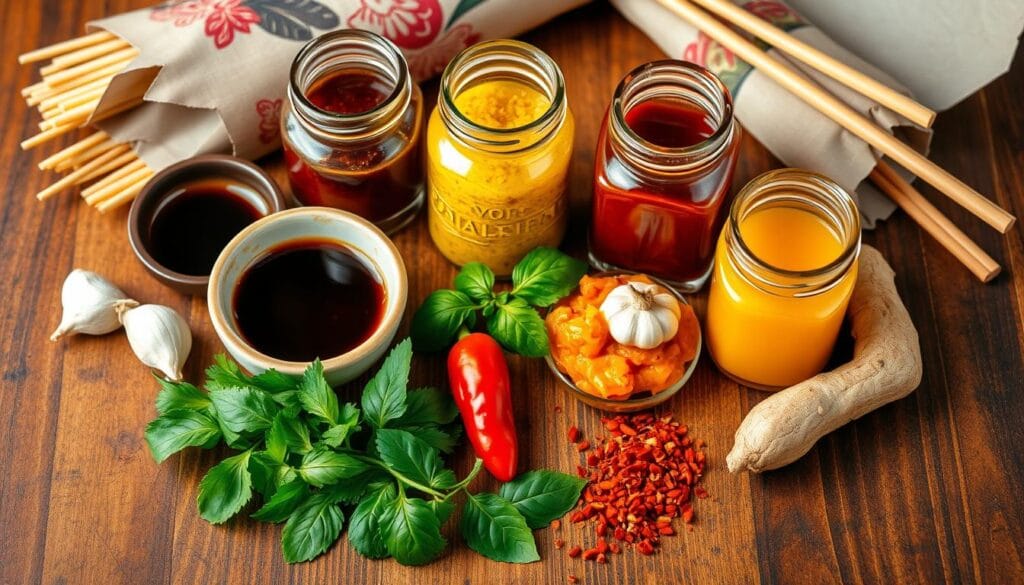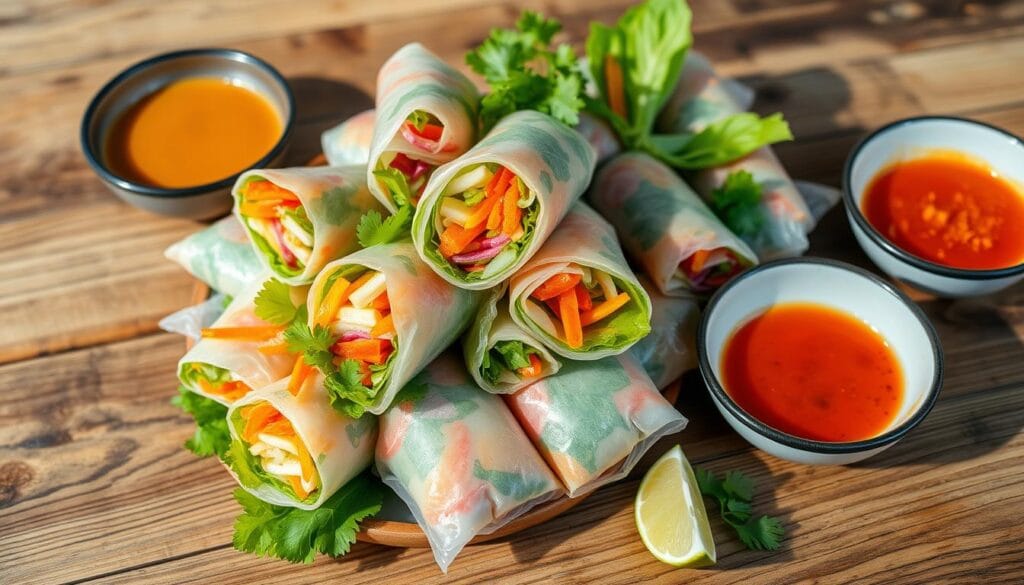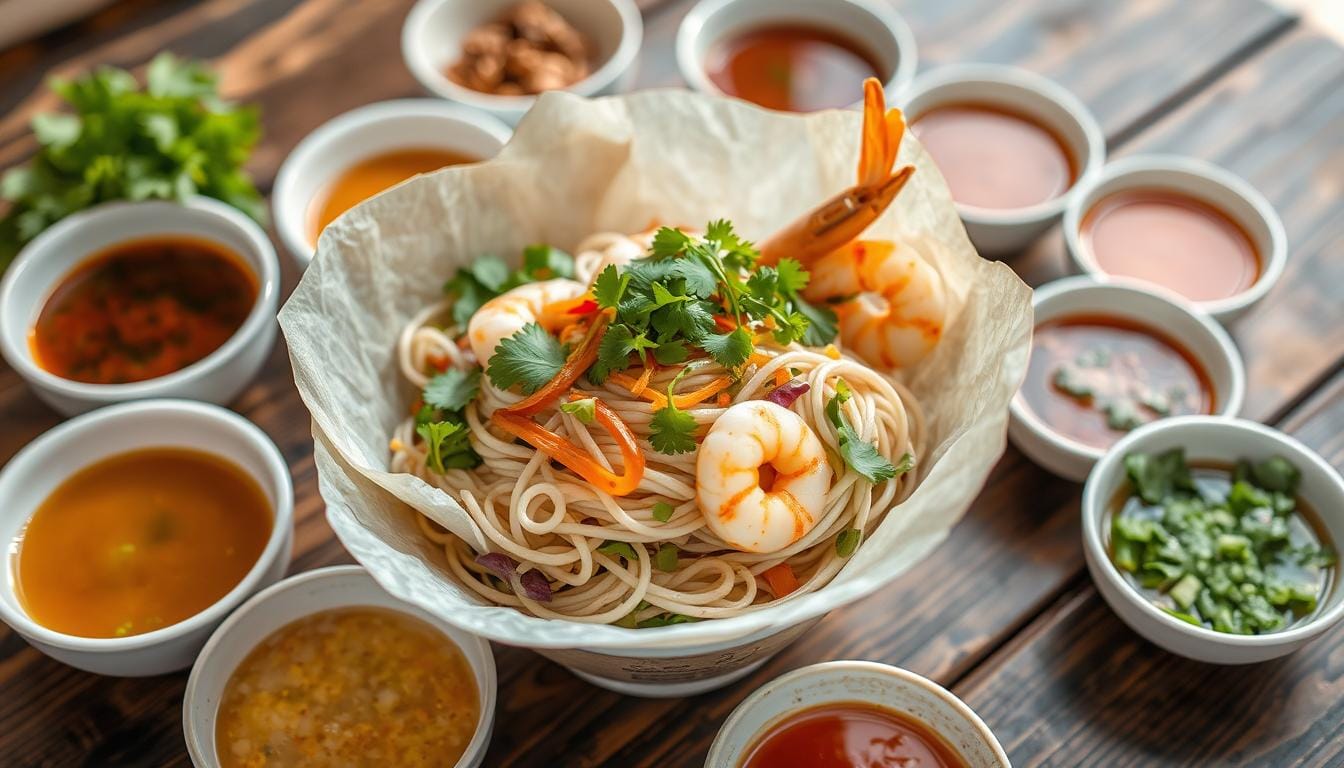Rice Paper Noodles: A Delicious Asian-Inspired Dish
Rice paper noodles have become very popular lately. They have won over food lovers all over the world. These noodles are a key part of Asian cooking, perfect for those who are gluten-free or vegan.
They are made from thin, clear rice paper sheets. This has made them a hit on social media, with lots of recipes popping up. People love their unique taste and texture.
These noodles are great for many Asian dishes. They are quick and easy to use, making them perfect for a fast meal or for trying new recipes. They fit many different diets, making them a favorite for many.
Table of Contents
Key Takeaways
- Rice paper noodles are a versatile and popular ingredient in Asian cuisine.
- They are naturally gluten-free and vegan, making them suitable for individuals with dietary restrictions.
- Rice paper noodles can be made from rice paper sheets typically used for spring rolls, offering a quick and easy alternative to traditional noodle-making methods.
- The dish has gained widespread popularity on social media, with various recipes and cooking techniques being shared extensively.
- Rice paper noodles can be customized with a variety of flavors and seasonings to suit personal preferences.
Understanding Rice Paper Noodles: Origins and Types
Rice paper noodles come from the rich Vietnamese cuisine. They are a key ingredient in dishes like spring rolls. But they can also be made into tasty noodles.
Traditional Vietnamese Origins
Rice paper noodles started in Vietnam. They are made from rice flour and water. This creates a thin, yet strong wrapper.
These sheets are the base for many Vietnamese dishes. They hold fresh fillings and herbs.
Different Types of Rice Paper Products
There are many types of rice paper noodles. They range from thin spring roll wrappers to thicker rice vermicelli strands. Each type has its own texture and use in cooking.
Cultural Significance in Asian Cuisine
Rice paper noodles are important in Asian food. They show the creativity and resourcefulness of traditional foods. They are loved in many Asian dishes, from Vietnamese cuisine to Japanese and Chinese.
Essential Ingredients and Kitchen Tools
To make tasty rice paper noodles, you need a few key ingredients and tools. First, you’ll need rice paper sheets. These thin, clear wrappers are the base of the dish. You’ll also need water to soak the rice paper, making it soft and easy to handle.
For preparing fillings or garnishes, a chopping board and a sharp knife are crucial. You can add herbs, spices, sauces, and other tasty ingredients. Think garlic, soy sauce, black vinegar, or chili flakes.
Don’t forget a large bowl for soaking the rice paper and a smaller bowl for sauces or seasonings. You can also add garnishes like scallions, sesame seeds, or cucumber to make the dish even better.
| Ingredient | Quantity |
|---|---|
| Rice paper sheets | 8 sheets |
| Water | Enough for soaking |
| Chopping board | 1 |
| Knife | 1 sharp knife |
| Garlic | 2 cloves |
| Soy sauce | 2 tablespoons |
| Black vinegar | 1 tablespoon |
| Chili flakes | 1 teaspoon |
| Large bowl | 1 |
| Small bowl | 1 |
| Scallions | 2 tablespoons, chopped |
| Sesame seeds | 1 tablespoon |
| Cucumber | 1/4 cup, diced |
With these ingredients and tools, you’re ready to make delicious rice paper noodles. They’re sure to impress your family and friends.
Step-by-Step Guide to Making Rice Paper Noodles
Making rice paper noodles is a fun way to add Asian flavors to your cooking. Whether you’re making a traditional Vietnamese dish or trying something new, learning to make these noodles is key. Let’s go through the steps to get the right texture and shape.
Proper Soaking Techniques
Begin by wetting your chopping board or a large flat surface. Place 2-3 rice paper sheets on top and soak them in room temperature water for 20-30 seconds. This softens them, making them easy to work with.
Cutting and Shaping Methods
Put the softened sheets on the wet surface, making sure to remove air bubbles. Use a sharp knife to cut the sheets into 6-8 strips. Dip the knife in water between cuts to avoid sticking. For thicker noodles, use 3 sheets at once.
Soak the cut noodles in water for about 15 minutes. This extra soaking makes them perfectly soft.
Tips for Perfect Texture
To get the best texture, microwave the noodles with a bit of water for one minute. This step gives them a chewy yet delicate feel, perfect for your dishes.
Follow these steps to make delicious, restaurant-quality rice paper noodles at home. Dive into the world of Asian cooking and let your creativity flow!
| Nutrition Facts (Per Serving) | Value |
|---|---|
| Calories | 84 |
| Total Fat | 0g |
| Cholesterol | 23mg |
| Sodium | 117mg |
| Carbohydrates | 16g |
| Dietary Fiber | 1g |
| Sugar | 2g |
| Protein | 4g |
Common Mistakes to Avoid When Preparing Rice Paper Noodles
Making rice paper noodles needs care and precision. To get perfect noodles, avoid these common mistakes:
- Don’t use warm water to soak the rice paper. It can make the noodles too soft and tear easily.
- Keep your chopping board or surface wet. This stops the rice paper from sticking when you cut and shape it.
- Make sure to remove any air bubbles from the rice paper. This keeps the noodles together and in shape.
- Soak the rice paper for at least 15 minutes before using it. Rushing this can make the noodles too hard or brittle.
- Enjoy your rice paper noodles right away. This prevents them from drying out or getting too soft in soups and sauces.
- Don’t freeze rice paper noodles. Freezing changes their delicate texture.
By avoiding these mistakes, you’ll make delicious rice paper noodles. They’ll be just right, full of flavor, and fun to eat.
| Ingredient | Amount | Purpose |
|---|---|---|
| Rice paper wrappers | 8 1/2 inch rounds | Primary noodle base |
| Rice vermicelli noodles | 1/2 package | Filling and texture |
| Cooked shrimp | 1/2 lb | Protein component |
| Mango slices | 1/2 cup | Sweet flavor and juicy contrast |
| Crushed peanuts | 2 tbsp | Crunchy garnish |
Mastering rice paper noodle making and avoiding these mistakes can make your Asian dishes better. With practice, your noodles will impress everyone.
Flavorful Sauce Combinations and Seasonings
Make your rice paper noodle dishes even better with tasty sauces and seasonings. Start with soy sauce, chili oil, and sesame oil. These are the basics for great flavor. For a tasty chili garlic sauce, mix garlic, soy sauce, black vinegar, and chili flakes.
Want to try something new? Try 5-spice powder or Sichuan pepper for a unique taste. You can also change the spice level by adding more chili flakes or using gochugaru. There are so many ways to mix Asian seasonings and sauces.
Traditional Asian Sauces
- Soy sauce
- Chili oil
- Sesame oil
Modern Fusion Options
- 5-spice powder
- Sichuan pepper
Spice Level Variations
Change the heat by adding more chili flakes or using gochugaru. Try different mixes to find your favorite taste.

“Discover the perfect balance of flavors to make your rice paper noodles shine.”
Healthy Benefits and Dietary Considerations
Rice paper noodles are a great choice for those who care about their health. They are gluten-free and vegan, perfect for people with dietary needs or preferences.
These noodles have fewer calories than regular pasta, with 85 to 120 calories per roll. They are high in carbohydrates, with about 18 grams per serving. They also have a good amount of protein, up to 26 grams, especially with fillings like chicken or shrimp.
Rice paper noodles have very little fat. Most of the fat comes from the fillings or sauces. This makes them great for those watching their fat intake or trying to lose weight.
These noodles are also a good source of vitamins and minerals. They have Vitamins A, C, and K, especially when paired with leafy greens and herbs. Shrimp adds minerals like iodine and zinc.
Even though rice paper noodles are healthier, it’s important to eat them in moderation. Eating too much can raise blood sugar levels. So, it’s best to balance them with whole, unprocessed foods.
To make rice paper noodles even healthier, try substituting tofu for shrimp. Add more veggies and use low-sodium or sugar-free sauces. This way, you can enjoy them more without compromising nutrition.
“Rice paper noodles offer a delicious and versatile option for health-conscious individuals, providing a gluten-free, vegan, and low-fat base for a wide range of flavorful and nutritious Asian-inspired dishes.”
Serving Suggestions and Accompaniments
When serving spring rolls or Asian-inspired meals, you have many options. Rice paper noodles can be the main attraction. They go well with a variety of tasty pairings and combinations of vegetables.
Protein Pairings
Add a protein to make your rice paper noodle dish even better. Try pairing it with crispy tofu, juicy chicken, or succulent shrimp. The noodles’ neutral taste lets the protein take center stage.
Vegetable Combinations
- Crisp bean sprouts
- Earthy mushrooms, like shimeji or enoki
- Refreshing cucumber slices
These vegetable pairings add texture and crunch. They also bring a burst of freshness to your dish.
Garnish Ideas
- Vibrant scallions, finely sliced
- Toasted sesame seeds for a nutty crunch
- Fragrant fresh herbs, such as cilantro
Adding these simple garnishes can make your dish look and taste amazing. It turns your rice paper noodle creation into a feast for the eyes and taste buds.

Rice paper noodles are very versatile. You can enjoy them in soups or salads. Pair them with your favorite Asian-inspired drinks, like a coconut matcha latte or Korean strawberry milk. It’s a great way to enhance your meal.
| Protein | Vegetables | Garnishes |
|---|---|---|
| Tofu | Bean sprouts | Scallions |
| Chicken | Mushrooms | Sesame seeds |
| Shrimp | Cucumber | Cilantro |
Storage Tips and Meal Prep Guidelines
Storing and preparing rice paper noodles needs some extra care. These noodles are best when fresh. They can dry out and become chewy if stored for too long. But, with a few tips, you can keep them fresh for longer and use them in meal prep.
Leftover rice paper noodles should be stored in an airtight container in the fridge for up to 3 days. To reheat, add a bit of water and microwave for about 1 minute. This will make them soft and pliable again.
For meal prep, prepare the sauce and chop veggies ahead of time. This makes it easy to put the dish together when you’re hungry. The dry rice paper sheets can be stored without freezing.
| Food Item | Refrigerator Storage |
|---|---|
| Cooked Vegetables | 3-7 days |
| Raw Salads | 3-5 days |
| Citrus and Berries | 3-5 days |
| Starchy Foods (rice, pasta, potatoes) | 3-5 days |
| Meats and Tofu | 2-4 days |
| Dairy and Eggs | 3 days |
| Cooked Meals | 2-4 days |
By using these storage tips and meal prep methods, you can enjoy rice paper noodles at their best. They’re perfect for a quick dinner or for meal prep throughout the week.
Conclusion
Rice paper noodles are a great choice for Asian-inspired dishes. They come from traditional Vietnamese cuisine. These delicate sheets can be used in many tasty ways.
They’re perfect for wrapping around veggies, lean proteins, or both. Rice paper noodles are also good for you, being low in fat and calories. They’re rich in fiber and complex carbs.
TANISA FOODS JSC makes rice paper noodles available worldwide. They’re gluten-free and offer many health benefits. TANISA helps you add this versatile ingredient to your cooking, bringing Asian flavors to your table.
Rice paper noodles are great for many dishes. They can be a light appetizer or a main course. With the right techniques and flavors, they can make any meal special.
FAQ
What are rice paper noodles?
Where do rice paper noodles originate from?
What are the different types of rice paper products?
What ingredients and tools are needed to make rice paper noodles?
How do you properly prepare and cut rice paper noodles?
What are some common mistakes to avoid when making rice paper noodles?
What sauces and seasonings pair well with rice paper noodles?
Are rice paper noodles a healthy option?
What are some ways to serve rice paper noodles?
How should rice paper noodles be stored and reheated?
Tried This Delicious Recipe Yet ?
There are no reviews yet. Be the first one to write one.

